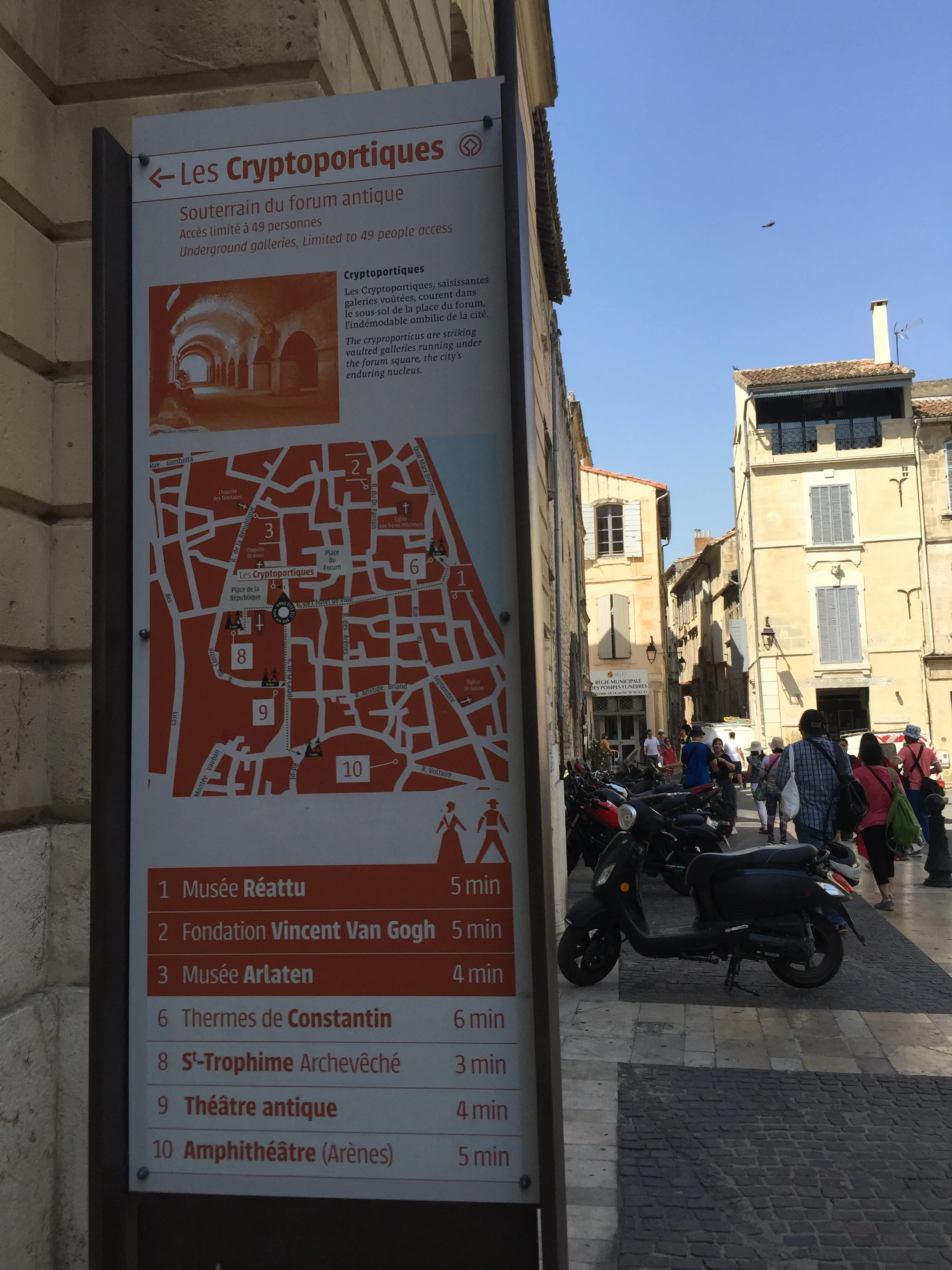表演場雙週刊第十二期 - 封面故事:南法表演藝術之旅- 阿維儂 The Art Venue Bi-Weekly Issue 012 - Cover Story: Performing arts tour in southern France – Avignon (20190815)
每年七月,位於法國南部普羅旺斯地區的亞維儂,較平常更為熱鬧,因為來自世界各地的表演團隊及觀眾,齊集到 這裡,參加一年一度的亞維儂藝術節。在第十期的《表演 場雙週刊》中,我們已經為大家介紹過在當地演出的香港作品; 同時也訪問了台灣當代傳奇劇場,他們的青年團- 興傳奇青年劇場,今年也有在那裡演出。七月底的時候, 場主剛好路過亞維儂,除了進城參觀外,也順道跟這兩個 演出團隊茶聚。今期跟大家介紹一下亞維儂,這個已列入 世界文化遺產的古城,讓有興趣將來到亞維儂參加藝術節 的朋友,可以有更多資料參考。
亞維儂藝術節主要分成兩大部分:官辦的 被稱為內藝術節(Festival d'Avignon, 簡稱Avignon IN),非官方同步舉辦 的就被稱為外藝術節(Festival OFF d'Avignon,又被稱為Avignon OFF), 有點像是愛丁堡藝術節和愛丁堡藝穂節 的關係。官方舉辦的亞維儂藝術節,始 於1947年,是現今法國歷史最悠久的藝 術節;而外亞維儂藝術節是於19年後, 即在1966年,才由民間的藝文界及劇場 界發起舉辦。
每年的Avignon IN,約有55個委約或受 邀的世界頂級作品演出,吸引世界各地 愛好表演藝術的人士慕名而來參加,其 特色之一,是將亞維儂的地標建築-教皇 宮變身成為演出場地。至於Avignon OFF,則吸引世界各地規模較小、具實 驗性或前衛性的表演團隊參與,有很多 業內人士會趁空檔看他們的節目,是團 隊上位的好機會。在2018年的Avignon OFF,便有多達有1,538演出、在133個 場地上演。
拍攝 Photo by: Winona
▲ 教皇宮是亞維儂的地標,每年藝術節期間會變 為最大的演出場地。
Palais des Papes is the landmark of Avignon. Every year, the historic palace is transformed into the largest performance venue for the Festival d’Avignon.
由於亞維儂是一座小古城,而每年藝術 節期間蜂擁而至的遊客、演出團隊、觀 眾非常多,如果要住在中心的位置,務 必要提早預訂酒店。古城有很多保存完 好的古蹟,亦不乏現代化的一面,單是 在共和大道上,便有很多時髦的商店、 餐廳。七月的亞維儂非常炎熱,在藝術 節舉行期間,可輕易找到戶外餐廳,而 且都裝有灑水系統,為顧客降降溫。另 外,由於街道仍保留著古舊的石磚路,根 據當地的導遊介紹,有法例規定,在亞維 儂城內,不可穿高跟鞋在街上走路,以避 免對古老石磚造成破壞。
回溯歷史,阿維儂是在1995年,被列入 聯合國世界歷史遺產:「這座位於法國南 部的城市是14世紀羅馬教皇的居所。教 皇宮其實就是一個裝飾豪華卻外表樸素 的城堡,由西蒙尼.馬蒂尼和馬泰奧. 喬瓦內蒂(Simone Martini and Matteo Giovanetti)裝修而成,佔據了 這座城市絕大部分面積,周圍是堅固 的城牆和12世紀阿維儂橋的遺址。在 卓越的哥特式建築之下,小宮殿和聖 母院的羅馬式主教堂古蹟實屬罕見, 證明了阿維儂在14世紀基督化歐洲所 發揮的領導作用。」
這裡亦曾發生重要的歷史事件,於公元 1309到1377期間的「亞維儂囚禁」(The Avignon captivity of the papacy或 Babylonian Captivity),曾有七位羅 馬教廷的教宗居住在現為法國領土的亞 維儂。1789年法國大革命期間,教皇宮 內大部分珍貴藏品遭士兵洗劫一空,後 來在拿破崙的時候,教皇宮殿更成為了 軍事基地及監獄用途。而到法國第三共 和時期,內部僅存的壁畫等也遭任意損 壞,但建築的外牆卻非常完整地保存到 現在,成為著名景點。
亞維儂位於普羅旺斯,周邊還有非常多 值得參觀的古城,在亞維儂的遊客中心 內可以查詢相關本地旅遊資料。場主非 常推薦大家可以去附近另一世界文化遺 產古城-亞爾(Arles)。由亞維儂到亞 爾,如果坐火車,大概半小時的車程。
亞爾城內羅馬遺跡處處,包括建於公元一 世紀、可容納超過二萬人圓形競技場,建 於公元前一世紀、可容納一萬人的圓形 劇場等等。著名畫家梵谷曾居於這裡兩 年,並創作了將近300多幅作品,包括著 名的「星空下的咖啡館」。城內店舖、餐 廳林立,很適合來個一天小旅行。
Every July, Avignon, an ancient town in Provence, France, is packed with tourists who come for two arts festivals: Festival d’Avignon and Avignon OFF. Festival d’Avignon, organised by the French government, was established in 1947 and is the oldest arts festival in France. The festival presents 55 world-class productions every year, all of which are created by invitation or by commission. Avignon OFF was established in 1966 by a group of art practitioners and features mainly experimental productions and new works by smaller performing arts companies. In 2018, Avignon OFF showcased 1,538 performances during the month-long festival.
UNESCO listed Avignon as a World Heritage Centre in 1995 for its significance in Roman Catholic history – the city was the seat of the papacy during the 14th century. UNESCO described the Palais des Papes as: “an austere-looking fortress lavishly decorated by Simone Martini and Matteo Giovanetti, [which] dominates the city, the surrounding ramparts, and the remains of a 12th-century bridge over the Rhone. Beneath this outstanding example of Gothic architecture, the Petit Palais and the Romanesque Cathedral of Notre-Dame-des-Doms complete an exceptional group of monuments that testify to the leading role played by Avignon in 14th-century Christian Europe.”
Even though Avignon is an ancient town, it is replete with fashion boutiques, shops, and restaurants. Avignon is sweltering all summer long, and outdoor restaurants roll out misters to cool the air. Inside the city centre, high heel shoes are not allowed, as Avignon tries to preserve its ancient roads.
It is easy to travel to other surrounding cities in Provence. One can travel from Avignon to Arles, another UNESCO World Heritage Centre, by train, and the trip takes only about 30 minutes.
UNESCO called Arles “a good example of the adaptation of an ancient city to medieval European civilisation. It has some impressive Roman monuments, of which the earliest – the arena, the Roman theatre, and the cryptoporticus (subterranean galleries) – date back to the first century B.C. During the fourth century Arles experienced a second golden age, as attested by the baths of Constantine and the necropolis of Alyscamps. In the 11th and 12th centuries, Arles once again became one of the most attractive cities in the Mediterranean. Within the city walls, Saint-Trophime, with its cloister, is one of Provence’s major Romanesque monuments.”
拍攝 Photo by: Winona
▲ 鄰近亞維儂的亞爾,古城內 有非常多的景點,吸引遊客特意來「打卡」。
Selfie spots are everywhere in Arles.



